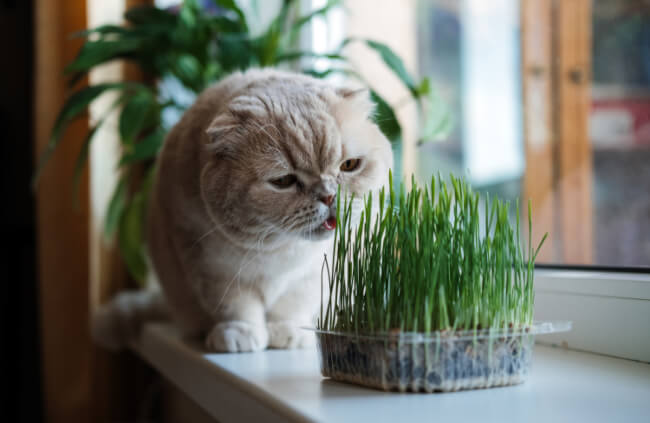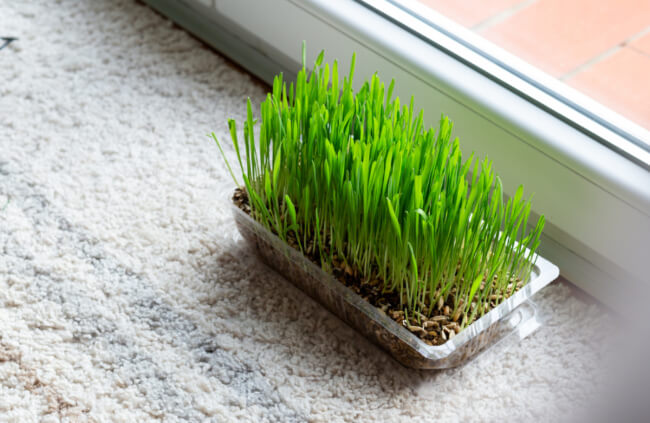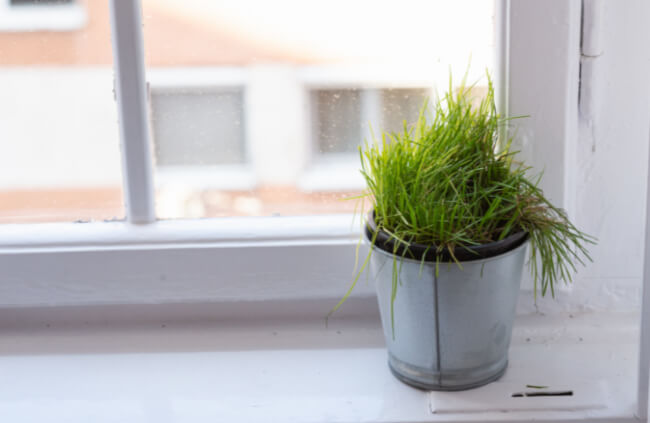If you’ve got a long-haired cat, or a shorthaired cat that overgrooms, there’s a really simple green solution for their hairball woes – cat grass. When cats are ill, whether it’s an upset tummy or a constant supply of hairballs being coughed up, they naturally seek out grass to calm their stomach, aid digestion and move things along.
If you’ve ever wanted to grow your own cat grass, or want a cheaper way to grow your own, without buying pots of the stuff from garden centres, then you’re in the right place, because we’ve got tips and tricks on growing your own cat grass, regardless of where you are, or the time of year.
More...

Genus: | Various |
|---|---|
Species: | Various |
Origin: | Global |
Common Names: | Cat Grass |
Location: | Indoor or outdoor |
Type: | Grass |
Growth: | up to 30 cm tall, if grown properly |
Sun requirements: | Varies, most light conditions will work |
Foliage Colour: | Green |
Flower Colour: | None (should be cut if it flowers) |
Flowering: | None |
Fruits: | None |
Maintenance level: | Low |
Poisonous for pets: | Non-toxic to cats and dogs |
What is Cat Grass?
Cat grass is a general term for any fast-growing, wide-bladed grass seed. It’s sold as a dietary support for cats, pre-grown in pots in pet shops, garden centres, and even some supermarkets, and really does help.
The only downside of cat grass is that not all cats like it, so before you put tons of effort into growing your own, check out how your cats respond to a pre-grown pot. It’ll set you back a couple of dollars, but it’s worth it to trial your feline friends before you invest time and effort in growing from seed.
Best Types of Cat Grass
Because cat grass is literally just grass, it’s as varied as any grass seed you can buy for your lawn. The most common varieties of cat grass are:
- Oatgrass (Arrhenatherum elatius)
- Barley Grass (Hordeum vulgare)
- Wheatgrass (Triticum aestivum)
- Ryegrass (Lolium perenne)
The reason wheat, rye, barley, and oat grass are so good for cats is that they are both fast-growing, and wide-bladed, which means they offer good roughage, and actively work as a mild laxative, to move your cat's digestion along, and hopefully shift some stubborn hairballs in the process.
Benefits of Cat Grass for cats

Cat grass is a great, natural dietary supplement for cats. Despite being carnivores, which means they can’t actually digest vegetables, or grass, properly, let alone chew it, the roughage it provides, means it helps to clear out their gut.
When stray cats or wild cat species find themselves with sore stomachs, whatever the reason, they instinctively chew foliage (houseplants are a common victim of cats with digestive problems for this very reason, so always make sure your house plants are cat-safe!).
The key proven benefits and effects of cat grass for cats are:
- Cat grass makes it easier for cats to regurgitate hairballs, reducing discomfort and stress in the process
- Cat grass has a mild laxative effect, helping cats to move along clogged-up tummies as well as clear out any potential gut problems caused by off food, etc.
- Cat grass can also induce vomiting, which might not seem like a good thing, but if your cat has eaten something it instinctively wants to get rid of (a slug for example), cat grass offers it an instinctive way to remove the threat of infection by vomiting it back up.
- Cat grass might, and I say might because it’s obviously unproven, be quite tasty to cats. It has very high nutritional value, s while they can’t actively digest it, some nutrients will be taken in, offering a vitamin boost along the way.
How to Propagate Cat Grass
Growing your own cat grass from seed is so fast that it’s got to be worth a try. In as little as a week, you can have a reasonably useful pot of cat grass, ready for your cats to nibble on. If you leave it for two or three weeks, you can have cat grass that’s 10-15cm long and offers copious amounts of fibre.
All cat grass seeds need to germinate is moisture and light, so you can literally grow cat grass in a plastic tub with paper towels stuffed into the bottom, but for more effective and long-term growth (and cat grass that can be reused when it is grown back) it’s best to grow it in a pot filled with free draining, clean compost).
Like sowing a lawn, cat grass seeds need regular moisture as they establish, so whether you sow it onto paper towels or soil, you’ll need to keep it reasonably well watered, and in bright conditions, until it’s ready to feed to your cat.

How to Grow Cat Grass in Australia
OK, so, we know the basics of cat grass propagation, but how do you keep it happy once it’s started? And what are the differences between growing cat grass in soil, to growing cat grass on paper?
Let’s take a closer look at a few different ways you can grow cat grass and the pros and cons of each.
Pot size for cat grass
Cat grass, if you’re growing it in soil, can be planted into any sized pot, but try to keep it portion sized. Don’t fill a whole seed tray with cat grass seeds, because it’ll just get walked on by your cats, and they can often mistake it for a natural litter tray!
We always grow our cat grass with a generous pinch of seeds in a 10 cm pot. That’s about ideal for a day’s worth of grass when your cat really needs it, and if you sow a few, you can rotate them, meaning the first one will grow back by the time your cat has eaten their way through the rest.
Soil requirements
Cat grass prefers quite sandy soil, but one that holds moisture. If you’ve got a basic organic compost, without any added chemical fertilisers, that will do nicely, but make sure your pot has plenty of drainage holes so your seeds don’t sit in soggy soil.
Light requirements
Like all grasses, cat grass seeds need reasonably bright light. You can germinate cat grass in most conditions, but growing it indoors will reduce the risk of other animals and insects crawling through it while you’re waiting.
I’d always suggest a bright windowsill in full sun but do make sure to keep it well-watered.
Watering cat grass
Cat grass should never be completely soaked. Wet cat grass, like a wet lawn, will struggle to root into its soil, so water sparingly once a day, or any time the soil is lightly dry to the touch.
As the grass establishes you can water less and less, basically responding to its needs. If it looks dry and it is wilting, check the soil. If it’s wet, it’s probably overwatered, so stop watering entirely, and move the pot somewhere warmer to dry out the soil. If it’s dry, water once every few days to keep it going.
Fertilising cat grass
Cat grass should not need any fertiliser or plant food, and it is potentially dangerous too. Any chemical or even organic fertilisers can upset a cat’s stomach, and grass doesn’t need it, especially not if it’s grown in a pot filled with good compost, which will provide more than enough nutrition for several months of regrowth.

Growing Cat Grass Without Soil
If you want to try growing cat grass without soil as if you were growing cress, it can be done on paper towels, and it will germinate. However, this cat grass will be a one-off, and you won’t be able to regrow it.
The same goes for growing cat grass in vermiculite. It’s a good growing medium for rapid germination, often providing you with edible cat grass within a week, but once it’s gone, it really is gone, and it won’t regrow.
If you want to try growing cat grass quickly though, this is the best method:
- Line the base of an old plastic fruit punt with tissue paper.
- Sprinkle over a generous pinch of cat grass seeds.
- Water it really well so the seeds are in direct contact with the tissue.
- Cover the container to keep humidity in, but open it once a day for a few minutes to let it breathe.
- Cat grass seeds should germinate in 48 hours.
- Keep the tissue moist, but not soaking wet.
- Cat grass should be 5 cm-10 cm tall after a week.
When is Cat Grass Ready to Feed to my Cat?
It can be hard to tell when cat grass is ready to feed a cat, but the tissue method is simple – just feed it as soon as it looks long enough to chew on (5-10 cm tall).
When growing cat grass in pots with soil or compost, it’s important to let the roots establish first. So, while you can feed your cat its first pot of cat grass after about two weeks, it’s worth waiting a little longer so the roots have taken hold.
It might seem obvious, but it is worth saying; if a cat chews cat grass, it will pull on it. If the grass isn’t rooted firmly it will pull each plant out individually. If the roots are firmly rooted, the cat can bite through the leaves, and when it’s finished eating you can move the pot to a sunny spot, water it again, and it will regrow, just like mowing a lawn!
Cat Grass Pests and Diseases
Like any grass, cat grass can succumb to infection, it can damp off in excessively moist conditions, or it can wilt in very hot weather. It can even host aphids and spider mites when grown indoors, but, and this is the most important thing to remember… cat grass is cheap. If your cat grass is diseased, just throw it away and start again.
It’s much safer to start again with cat grass than risk giving your cat grass with fungal problems. Aphids are herbivorous, so don’t carry transmittable diseases, but whatever pest you find on your cat grass, it's best to just dispose of the whole lot on your compost heap.
Cat Grass Frequently Asked Questions

How do you know when to water cat grass?
Water cat grass whenever the soil surface is dry. Like lawn grass, cat grass needs a ready supply of moisture, but not too much, to live happily and thrive. Regular but sparse watering is advisable, but check each pot to make sure it’s not too wet before watering again.
Is cat grass just oats?
Cat grass is just oats, barley, wheat, or ryegrass. There’s nothing particularly special about it other than their collective qualities, such as wide blades, fast germination, and easy growing.
Is too much cat grass bad?
Cat grass isn’t toxic to cats, but it does induce vomiting, so while an entire patch of grass isn’t a good thing for your cat, it will just cause them to throw up, and shouldn’t cause any serious harm. Avoid giving your cat too much cat grass at any one time, so they still feel the benefit.
Do indoor cats like cat grass?
Even indoor cats like cat grass. Despite never having known the outside world, something inside them will instinctively tell them that cat grass is a healthy addition to their diet. Whether it’s the flavour, texture, or an innate calling, most cats will eat cat grass.
Can I repot cat grass?
Any cat grass that has been grown in a shallow pot can be repotted into a similarly shallow, but wider pot, and will spread out to fill its container in time.
What are common problems when growing cat grass?
One of the most common problems when growing cat grass is birds eating your seed. If you sow cat grass outdoors, birds will be drawn to it and can dig it up, even if it’s covered with soil. Avoid sowing cat grass outside, and you won’t have that problem.
Wrapping Up Our Cat Grass Growing Guide
Cat grass is a great addition to any feline household. Cats love it, and you’ll love the calmer cat it creates. OK, so it’s not like catmint. You’re not going to get hilarious videos of them going out of their mind on a catnip high, but it settles their stomachs, and in turn, it settles their minds.
If you have space on your windowsill for just one pot of catmint, then grow it. You won’t regret it, and you can’t go wrong!
Published on July 13, 2023 by Maisie Blevins
Last Updated on January 27, 2024




